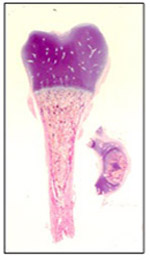Glucocorticoids: growth inhibitors

The following article analyses the role played by glucocorticoids in inhibiting foetal development in humans. Until now it was known that the localised action of GCs on growing cartilage directly affected agents such as insulin like growth factors (IGFs). Nevertheless, the in vivo expression of IGF-1 and IGF-2 signals seem to depend on the observation technique used and on the age of the animal being studied. What does seem clear however is that the disruption of these signals causes severe intrauterine growth retardation. By researching with human foetal epiphyseal chondrocytes, scientists were able to observe that the inhibiting mechanism of glucocorticoids directly affects the gene expression of cartilage, i.e. the expression of IGF-I but not of IGF-II signals. It must be highlighted that in the case of humans IGF-II expression does not vary according to the concentration levels of GCs. This demonstrates that only the IGF-I expression is inhibited significantly during the cartilage growth process in human foetuses.
Various clinical conditions, such as juvenile rheumatoid arthritis and chronic asthma, require prolonged glucocorticoid (GC) therapy which is associated with marked skeletal growth retardation in children. Studies in experimental animal models have also shown that high levels of GCs have a suppressive effect on longitudinal bone growth. Multiple mechanisms have been proposed to explain the growth-suppressing effect of supraphysiological GC. GCs have been shown to act locally by inhibiting longitudinal growth, thereby suggesting a local mechanism within the growth plate. The inhibitory actions of GCs on longitudinal growth are suggested to be due to impaired action of the components of the insulin-like growth factor (IGF) axis. Involvement of IGFs in fetal growth regulation has been demonstrated both in the animal models of IGF-I or IGF-II signalling disruption and the human patient with IGF-I gene deletion which resulted in severe intra-uterine growth retardation. Several in vitro data have shown expression of both IGFs in the growth plate, while several in vivo studies have shown conflicting results, with IGF-II being the most abundant, whereas IGF-I could only be detected depending on animal ages or techniques used.
Paracrine, autocrine and hormonal regulation of skeletal growth.
In order to elucidate the involvement of IGF axis components and the potential effects of GCs in human fetal growth regulation, we studied the regulation by GCs of proliferation and IGF axis components and matrix protein gene expression in human fetal epiphyseal chondrocytes.
Results suggest that one of the mechanisms for high-dose GC inhibition of fetal growth could be local inhibition of proliferation and gene expression in the growth plate. Our results demonstrated that chondrocytes from human fetal growth plate expressed IGF-I and suggested that, although IGF-II gene expression was higher than that of IGF-I, IGF-II expression is not regulated by GC, which does not support its role in human fetal growth plate regulation by GC whereas IGF-I expression was significantly inhibited.
References
Fernandez-Cancio M, Esteban C, Carrascosa A, Toran N, Andaluz P, Audi L. IGF-I and not IGF-II expression is regulated by glucocorticoids in human fetal epiphyseal chondrocytes. Growth Horm IGF Res. 2008 Dec;18(6):497-505. Epub 2008 Jun 2.

